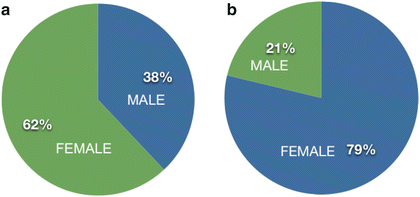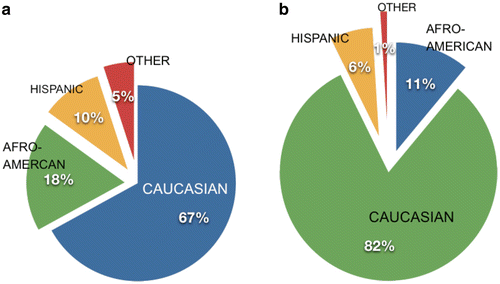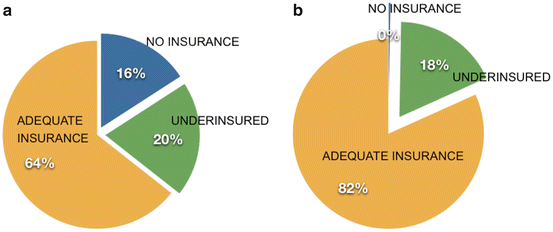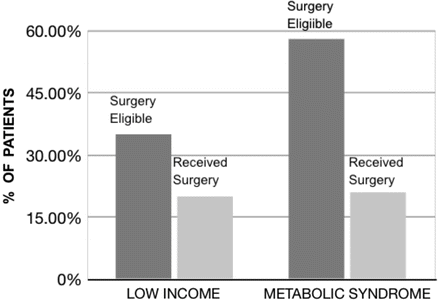(1)
Obesity Institute, Geisinger Medical Center, Southold, NY, USA
Abstract
The American Medical Association now recognizes obesity as a disease at a time when updated guidelines for referral and triage of patients to bariatric surgery and enhanced involvement of primary care physicians in obesity care are badly needed. The current body mass index-based eligibility criteria for bariatric surgery frequently exclude disabled severely obese patients for whom there is little else to offer for weight loss. In addition, patients with extreme obesity who have minimal health issues have uninhibited access to bariatric surgery. It is evident that updated guidelines based more on medical need than pure weight criteria are badly needed to improve access of deserving patients to bariatric surgery. The patients who actually receive bariatric surgery today are not a true reflection of the population of deserving patients with extreme obesity with respect to gender, race, insurance coverage, socioeconomic status, and comorbid disease burden. The vast majority of minority group patients with extreme obesity, limited education, limited income, and poor insurance coverage regularly obtain medical care at clinics and emergency rooms and currently have no access to bariatric surgery. This has created a major health problem because of the huge costs of inadequately treated extreme obesity and the potential cost-effectiveness of bariatric surgery. One-fifth of patient visits to primary care physicians relate to health problems caused by extreme obesity. Despite this, primary care physicians are reluctant to refer eligible patients to bariatric surgery programs and do not provide patient education concerning alternative obesity treatments. Improved communication and collaboration between primary care physicians and bariatric treatment programs are essential in order to improve physician education and eliminate individual bias.
Indications and Patient Access
The current indications for bariatric surgery are derived from the findings of a National Institute of Health (NIH) Consensus Conference convened in 1991, which established the current criteria for eligibility for bariatric surgery (Table 2.1) [1]. These guidelines, which are primarily based on body mass index (BMI), adequately reflect the medical evidence at the time. However, increasing numbers of bariatric surgeons now feel that more up-to-date revised guidelines for eligibility for surgical treatment are badly needed [2–7].
National Institute of Health (NIH) criteria for bariatric surgery: |
|---|
• Motivated patients with body mass index (BMI) ≥40 kg/m2 |
• Failure of medical weight loss treatment |
• BMI 35–40 kg/m2 with severe comorbid conditions, which are life threatening or interfere with employment and family function |
In the 22 years since the indications for bariatric surgery were established, accumulated knowledge has provided greater insight regarding patient factors which contribute to health risks of untreated morbid obesity to surgical risks, to the risks of long-term complications, and to poor weight loss outcomes. Bariatric surgeons are now in a much better position to make triage decisions regarding surgical candidacy and identify those with the most to gain and perhaps the most to lose with weight loss surgery.
The current BMI-based system for patient eligibility for bariatric surgery does not consider medical need. In the current system, healthy patients with extreme obesity have access to surgery, while disabled patients, for whom bariatric surgery may be the best practice recommended treatment, are frequently denied access to surgery. A number of recent studies point out that the demographics of those who currently undergo bariatric surgery do not reflect the demographics of the US population with extreme obesity in regard to gender, race, obesity disease burden, socioeconomic status, and geographic distribution [2, 3, 6, 7]. A recent study compared a large cohort of patients (n = 22,151,116) eligible for bariatric surgery from the National Health and Nutrition Examination Survey with a cohort (n = 87,749) who actually underwent bariatric surgery using the 2006 Nationwide Inpatient Sample. This study found significant disparities between the two cohorts in regard to gender, race, insurance coverage, socioeconomic status, and comorbid disease burden [3].
The population characteristics of those eligible for bariatric surgery [3] are compared with the characteristics of bariatric surgery patients from a large clinical registry of 57,918 patients [8] in relation to gender (Fig. 2.1a, b) and race (Fig. 2.2a, b) [3, 8]. The disproportionate access of Caucasians to bariatric surgery at the expense of eligible Afro-Americans is confirmed in other studies of socioeconomic mismatch in bariatric surgery [2, 6].



Fig. 2.1
(a) Gender distribution among patients eligible for bariatric surgery as determined from census data. Adapted from Martin M, Beekley A, Kjorstad R, et al. Socioeconomic disparities in Eligibility and Access to Bariatric Surgery: a National Population-based Analysis. Surg Obes Relat Dis 2010;6:8–15 [3]. (b) Gender distribution among patients who undergo bariatric surgery as determined from a large clinical registry. Adapted from DeMaria E, Pate V, Warthen M, Winegar D. Baseline data from American Society for Metabolic and Bariatric Surgery-designated Bariatric Surgery Centers of Excellence Using the Bariatric Outcomes Longitudinal Database. Surg Obes Relat Dis 2010;6:347–355 [8]

Fig. 2.2
(a) Race distribution among those eligible for bariatric surgery as determined from census data. Adapted from Martin M, Beekley A, Kjorstad R, et al. Socioeconomic disparities in Eligibility and access to Bariatric Surgery: a National Population-based Analysis. Surg Obes Relat Dis 2010;6:8–15 [3]. (b) Race distribution among those who undergo bariatric surgery as determined from a large clinical registry. Adapted from DeMaria E, Pate V, Warthen M, Winegar D. Baseline Data from American Society for Metabolic and Bariatric Surgery-designated Bariatric Surgery Centers of Excellence Using the Bariatric Outcomes Longitudinal Database. Surg Obes Relat Dis 2010;6:347–355 [8]
Additional comparisons of patient characteristics between the bariatric eligible population as determined by national census data and patients actually receiving bariatric surgery reveal additional disparities in regard to insurance status (Fig. 2.3a, b) [3], level of income, and prevalence of metabolic syndrome (Fig. 2.4) [3]. The distribution of bariatric surgery patients by BMI includes a relatively small fraction of the total patients with BMI ≥ 50 kg/m2, despite the fact that the prevalence of superobesity has increased at a much greater rate in recent years and is accompanied by greater health risks (Fig. 2.5) [2, 8, 9].




Fig. 2.3
(a) Insurance status among patients eligible for bariatric surgery as derived from census data. (b) Insurance status among those who undergo bariatric surgery. Adapted from Martin M, Beekley A, Kjorstad R, et al. Socioeconomic disparities in Eligibility and Access to Bariatric surgery: a National Population-based Analysis. Surg Obes Rel at Dis 2010;6:8-15 [3]

Fig. 2.4
Comparison of income status and prevalence of metabolic syndrome in those eligible for bariatric surgery versus those who actually undergo the surgery. Adapted from Martin M, Beekley A, Kjorstad R, et al. Socioeconomic disparities in Eligibility and Access to Bariatric surgery: a National Population-based Analysis. Surg Obes Rel Dis 2010;6:8–15 [3]

Fig. 2.5
Body mass index (BMI) distribution of those who undergo bariatric surgery as determined by a large clinical registry. Adapted from DeMaria E, Pate V, Warthen M, Winegar D. Baseline Data from American Society for Metabolic and Bariatric Surgery-designated Bariatric Surgery Centers of Excellence Using the Bariatric Outcomes Longitudinal Database. Surg Obes Relat Dis 2010;6:347–355 [8]
These results indicate that the population currently receiving bariatric surgery is predominantly Caucasian, female, young, and privately insured; with high incomes and a relatively low BMI; and is not truly representative of the bariatric eligible population. The current criteria for bariatric surgery eligibility and the limited patient access to surgery exclude large numbers of deserving minority patients who have limited education, limited income, and poor insurance coverage. For many of these excluded patients, bariatric surgery is not merely a treatment option, but the preferred best practice recommendation [4].
Stay updated, free articles. Join our Telegram channel

Full access? Get Clinical Tree








